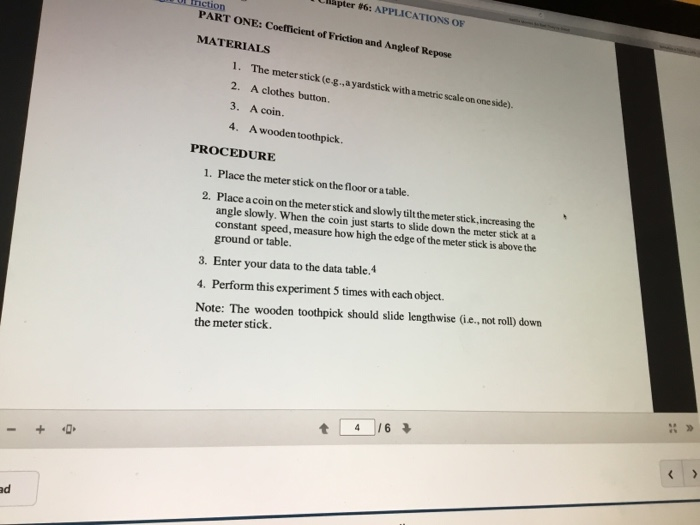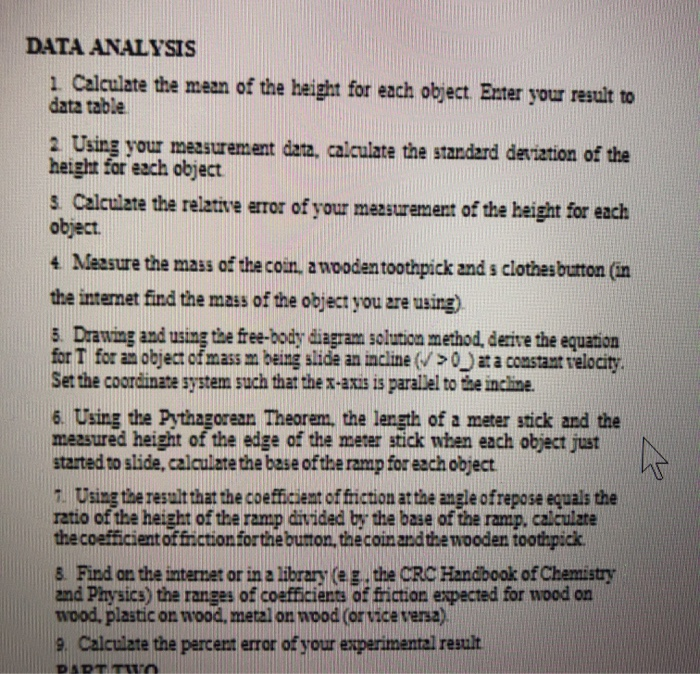LICATIONS OF PART ONE: Coefficient of Friction and Angle of Repose MATERIALS 1. The meter stick (e.g.,a yardstick with a metric scale on one side). 2. A clothes button. A coin. 4. A wooden toothpick. PROCEDURE 1. Place the meter stick on the floor or a table. 2. Place a coin on the meter stick and slowly tilt the meter stick, increasing the angle slowly. When the coin just starts to slide down the meter stick at a constant speed, measure how high the edge of the meter stick is above the ground or table. 3. Enter your data to the data table.4 4. Perform this experiment 5 times with each object. Note: The wooden toothpick should slide lengthwi 3.
LICATIONS OF PART ONE: Coefficient of Friction and Angle of Repose MATERIALS 1. The meter stick (e.g.,a yardstick with a metric scale on one side). 2. A clothes button. A coin. 4. A wooden toothpick. PROCEDURE 1. Place the meter stick on the floor or a table. 2. Place a coin on the meter stick and slowly tilt the meter stick, increasing the angle slowly. When the coin just starts to slide down the meter stick at a constant speed, measure how high the edge of the meter stick is above the ground or table. 3. Enter your data to the data table.4 4. Perform this experiment 5 times with each object. Note: The wooden toothpick should slide lengthwi 3.
Physics for Scientists and Engineers, Technology Update (No access codes included)
9th Edition
ISBN:9781305116399
Author:Raymond A. Serway, John W. Jewett
Publisher:Raymond A. Serway, John W. Jewett
Chapter4: Motion In Two Dimensions
Section: Chapter Questions
Problem 4.35P: Casting molten metal is important in many industrial processes. Centrifugal casting is used for...
Related questions
Concept explainers
Angular speed, acceleration and displacement
Angular acceleration is defined as the rate of change in angular velocity with respect to time. It has both magnitude and direction. So, it is a vector quantity.
Angular Position
Before diving into angular position, one should understand the basics of position and its importance along with usage in day-to-day life. When one talks of position, it’s always relative with respect to some other object. For example, position of earth with respect to sun, position of school with respect to house, etc. Angular position is the rotational analogue of linear position.
Question

Transcribed Image Text:I
+
ad
Ô
apter #6: APPLICATIONS OF
riction
PART ONE: Coefficient of Friction and Angle of Repose
MATERIALS
1. The meter stick (e.g.,a yardstick with a metric scale on one side).
2.
A clothes button.
A coin.
4.
A wooden toothpick.
PROCEDURE
1. Place the meter stick on the floor or a table.
2. Place a coin on the meter stick and slowly tilt the meter stick, increasing the
angle slowly. When the coin just starts to slide down the meter stick at a
constant speed, measure how high the edge of the meter stick is above the
ground or table.
3. Enter your data to the data table.4
4. Perform this experiment 5 times with each object.
Note: The wooden toothpick should slide lengthwise (i.e., not roll) down
the meter stick.
4
/6
3.
<
>

Transcribed Image Text:DATA ANALYSIS
1. Calculate the mean of the height for each object. Enter your result to
data table
2. Using your measurement data, calculate the standard deviation of the
height for each object
3. Calculate the relative error of your measurement of the height for each
object.
4 Measure the mass of the coin, a wooden toothpick and s clothes button (in
the internet find the mass of the object you are using).
5. Drawing and using the free-body diagram solution method, derive the equation
for T for an object of mass m being slide an incline (>0) at a constant velocity.
Set the coordinate system such that the x-axis is parallel to the incline.
6. Using the Pythagorean Theorem, the length of a meter stick and the
measured height of the edge of the meter stick when each object just
started to slide, calculate the base of the ramp for each object.
7. Using the result that the coefficient of friction at the angle ofrepose equals the
ratio of the height of the ramp divided by the base of the ramp, calculate
the coefficient of friction for the button, the coin and the wooden toothpick
8. Find on the internet or in a library (eg. the CRC Handbook of Chemistry
and Physics) the ranges of coefficients of friction expected for wood on
wood, plastic on wood, metal on wood (or vice versa).
9. Calculate the percent error of your experimental result
PART TWO
K
Expert Solution
This question has been solved!
Explore an expertly crafted, step-by-step solution for a thorough understanding of key concepts.
This is a popular solution!
Trending now
This is a popular solution!
Step by step
Solved in 2 steps

Knowledge Booster
Learn more about
Need a deep-dive on the concept behind this application? Look no further. Learn more about this topic, physics and related others by exploring similar questions and additional content below.Recommended textbooks for you

Physics for Scientists and Engineers, Technology …
Physics
ISBN:
9781305116399
Author:
Raymond A. Serway, John W. Jewett
Publisher:
Cengage Learning

College Physics
Physics
ISBN:
9781938168000
Author:
Paul Peter Urone, Roger Hinrichs
Publisher:
OpenStax College

An Introduction to Physical Science
Physics
ISBN:
9781305079137
Author:
James Shipman, Jerry D. Wilson, Charles A. Higgins, Omar Torres
Publisher:
Cengage Learning

Physics for Scientists and Engineers, Technology …
Physics
ISBN:
9781305116399
Author:
Raymond A. Serway, John W. Jewett
Publisher:
Cengage Learning

College Physics
Physics
ISBN:
9781938168000
Author:
Paul Peter Urone, Roger Hinrichs
Publisher:
OpenStax College

An Introduction to Physical Science
Physics
ISBN:
9781305079137
Author:
James Shipman, Jerry D. Wilson, Charles A. Higgins, Omar Torres
Publisher:
Cengage Learning